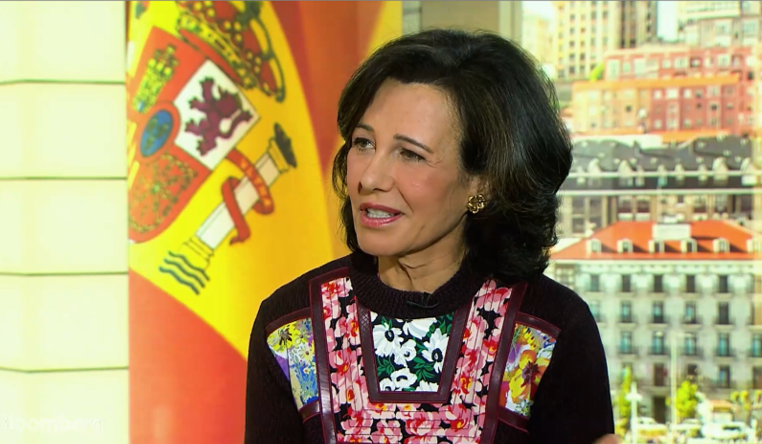
Really interesting interview here with Ana Botin, Executive Chair of Santander, on Bloomberg.
It starts with talking about how Santander can make a difference on climate change with Ana claiming that the bank is voted the most sustainable bank in the world. But when the interviewer, Erik Schatzker, asks her how Santander is making a real difference on the climate crisis, she qualifies this. Erik asks her why she doesn’t just stop funding fossil fuel firms. Ana responds:
“That wouldn’t be responsible. We cannot just cut the energy off in Poland, where a lot of the economy is still powered by coal. But we did announce, and we are one of the big banks in Poland, that we are not going to finance any new coal projects. You have to find a sensible balance between transforming and supporting our customers. We have a mission to help people and customers prosper in a sustainable way.”
She is then pressed on why the bank is not valued higher, as it’s diverse across Europe and the Americas and yet valued like a European bank. Ana responds by saying they are not well known enough, but that they are growing and focusing particularly on the Americas, as it’s more profitable. She claims they have 144 million customers and that’s double the amount of the largest US bank.
So, what’s the problem in valuation and how do you solve it? Ana states:
“We’re the most predictable bank in the world. We didn’t have one single quarter of losses in the last twenty years. Throughout the financial crisis, not one. We have grown our earnings, and this is something that is very valuable.”
However, she does make quite clear that there is an issue in the UK with capital allocation, which is the country that is under performing generally within the Group.
The interview then moves to scale and capability.
“We have scale in number of customers, and we have scale in technology investment. We have committed $20 billion for the next three years. We are building Santander global platform. This is a global financial services bank with a very strong payments business at the core. Let me give you one example: Open Bank. It’s the largest digital bank in Europe by number of deposits. We launched in Germany, Holland and Portugal, as we speak, and we are doing that with the same software. Single software developed by Santander in open digital services for all the countries, running on the cloud. Our expansion will come through the digital platform. We do not need to buy physical assets. If we didn’t have the scale, we could never afford this investment. By the way, we are opening Open Bank in Argentina, Mexico and the US in the next couple of years. In the context of the US, we are the third largest bank in terms of the size we invest in technology.”
There’s then a talk about their expansion in the South Americas, and Brazil in particular where Santander generates 30% of their profit, and Ana makes clear their focus is across all of the market from retail banking through wealth management, and that it’s a strength of their business to be diversified across geographies and markets.
The interview moves on to how Santander is punching below its weight in the USA, even with 17,000 employees and $145 billion in assets. Ana claims its down to legacy. For the last five years, they’ve been fixing legacy issues in the USA and are now ready for growth. Erik goes on to press her about the US business, and asks why she doesn’t just sell it as it’s not succeeding? She underlines that the US is a core part of their business, and the relationship between the US and the South Americas and Europe. What about the brand? She dodges that one.
Erik then asks why she advocates an issue about banks being regulated different to tech firms?
“Our strategy is to grow loyal customers. If I asked you who your bank was, you would probably think of one bank even though you might have five accounts. For that to be the case, I need to know you and that’s based on data. Why should data be regulated in a different way if you’re called a bank and if you’re called something else … more than two billion people have a digital wallet. When you have a digital wallet, who should be part of that arrangement? Just the user and the phone provider? Or the company issuing the card also? This is where we need clarity.”
Does Santander partner with tech firms, like JPMC and others do?
“We’re 100% in favour of innovation… We’ve partnered with Kabbage, Ripple, and many other American companies. What we’re doing is we want to take these companies and services when we don’t approve a loan, we can pass it on to Kabbage; Ripple is at the base of One Pay FX blockchain base [system.]”
Fascinating interview, and well worth 25 minutes of your time.
Chris M Skinner
Chris Skinner is best known as an independent commentator on the financial markets through his blog, TheFinanser.com, as author of the bestselling book Digital Bank, and Chair of the European networking forum the Financial Services Club. He has been voted one of the most influential people in banking by The Financial Brand (as well as one of the best blogs), a FinTech Titan (Next Bank), one of the Fintech Leaders you need to follow (City AM, Deluxe and Jax Finance), as well as one of the Top 40 most influential people in financial technology by the Wall Street Journal's Financial News. To learn more click here...

